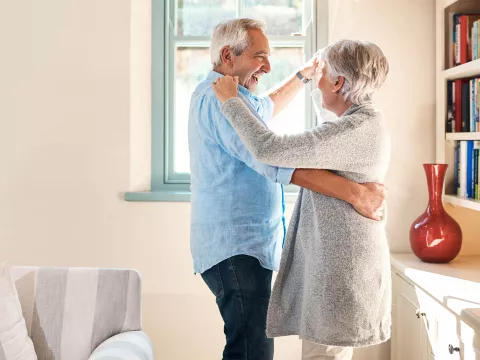- AdventHealth

With an overactive bladder (OAB) comes the continual urge to urinate. And for many people, the issue is further compounded by leakage. If you’re dealing with frustrating urges and leaks, you certainly aren’t alone. It’s estimated that nearly 33 million people in the United States live with this condition.
Left untreated, OAB can affect the overall quality of your life. It may make you feel embarrassed or cause you to isolate yourself, limiting your career and social life. You may also experience:
- Anxiety
- Depression
- Emotional distress
- Intimacy issues
- Sleep disturbances
But the good news is that OAB is very treatable.
“Many people assume the symptoms of an overactive bladder are an inevitable part of growing older,” says urologist Paul Arnold, MD. “In fact, this misconception is so common less than half of the people with incontinence ever consult a doctor for help. But there are many treatments available for OAB, and even though it can feel embarrassing to talk about, your doctor can help.”
What Is an Overactive Bladder?
Your bladder, muscles and brain all work together as part of an intricate system. Your bladder is designed to hold urine until you’re ready to empty it; your muscles to contract or relax based on automated signals from your brain.
When your bladder gets about halfway full, your brain gets a signal that it needs to be emptied. This signal can automatically prompt your bladder muscles to contract and your sphincter muscle to relax. Incontinence (urine leakage) happens when your body has a problem coordinating this system.
There are several different types of incontinence:
- Functional incontinence happens when you have a mental or physical condition that keeps you from getting to the bathroom in time, such as severe arthritis or dementia
- Mixed incontinence describes when you experience more than one type of incontinence
- Overflow incontinence happens when your bladder doesn’t completely empty, causing frequent dripping or leaking of urine
- Stress incontinence happens when urine leaks when you cough, sneeze, laugh, exercise or lift something heavy
- Urge incontinence describes a sudden, intense urge to urinate followed by an involuntary loss of urine
“Women with OAB sometimes experience both urgency and stress incontinence at the same time, explains Dr. Arnold. “Treating stress incontinence will not necessarily improve OAB symptoms. And treating an overactive bladder might not help stress incontinence symptoms.”
Some people experience both bladder storage and bladder-emptying issues, which requires the help of a urologist like Dr. Arnold.
What Causes OAB?
People with overactive bladder frequently experience a sudden, urgent need to urinate, but can’t get to a bathroom before they lose control.
“The urgent sensation to urinate can be triggered by things as common as the sound of running water,” says Dr. Arnold. “Sometimes even just thinking about urinating can be a trigger.”
Since there is a range of conditions that can contribute to an overactive bladder, it can be difficult to identify the specific cause. However, OAB causes can include:
- Constipation
- Diabetes
- Enlarged prostate
- Hormonal changes during menopause
- Neurological disorders like multiple sclerosis and strokes
- Previous operations to treat other forms of incontinence
- Tumors or bladder stones
- Urinary tract infections
Other factors that may impact your bladder activity include:
- Declining cognitive function due to aging
- Difficulty walking
- Excess caffeine or alcohol consumption
- Incomplete bladder emptying
- Medications that cause a rapid increase in urine production
- Medications that must be taken with lots of fluids
“If you’re urinating at least eight times a day and waking up at night to urinate more than once, you likely have OAB,” Dr. Arnold says.
Whole-Person Treatment for OAB
The first step in finding relief is visiting a doctor who can evaluate your condition, provide an accurate diagnosis and determine the best course of treatment — which could include behavioral modifications, non-invasive treatments, surgery or medication.
At AdventHealth, our whole-person approach to health means you’ll have access to a variety of treatments that will address your needs in body, mind and spirit.
Some of the behavioral modifications and non-invasive treatments that can help you manage OAB include:
- Biofeedback
- Bladder retraining
- Dietary changes and maintaining a healthy weight
- Exercise and physical activity
- Fluid management and limiting caffeine and alcohol
- Injection therapy
- Pelvic floor muscle exercises
- Quitting smoking
- Sacral nerve stimulation
When non-invasive options alone aren’t helping ease your OAB, your doctor may recommend prescription medications. Pharmaceutical treatments can help calm the nerves in the bladder to strengthen your bladder control and relieve the feeling of urgency.
While surgery for OAB is rare, if you’re experiencing severe symptoms, your doctor and urologist may recommend it.
Personalized Care Can Help You Reclaim Your Life
If an overactive bladder is keeping you from living your best life, we’re here to help. Whether you’re making too many trips to the bathroom or you think something more serious is going on with your bladder, the urology team at AdventHealth can put you on the path to whole health. Click here to learn more about Dr. Arnold and request an appointment.



